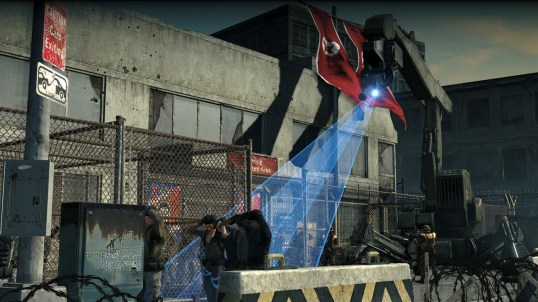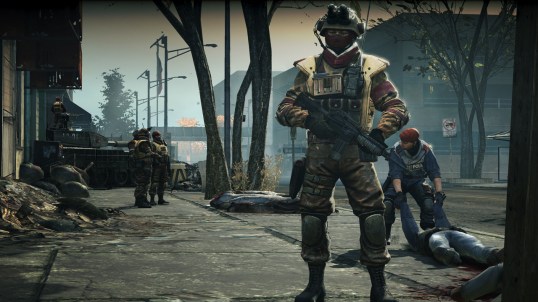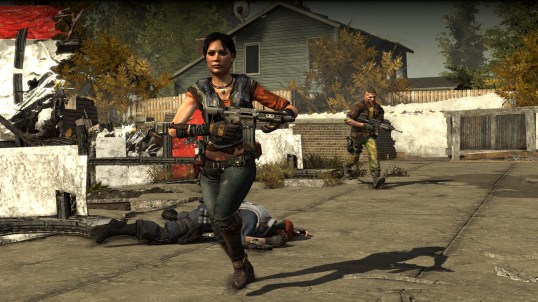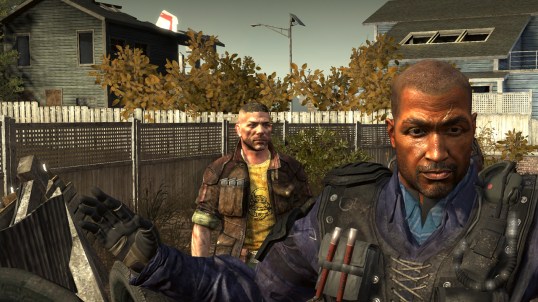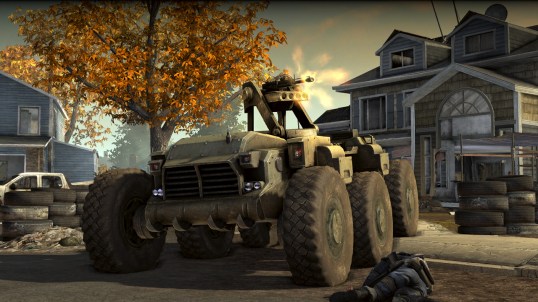War video games tend to use place in one of two ways. The first method puts players on unfamiliar territory and the battles to save everything you hold dear take place in a faraway land, where you’re taking the fight to a foreign enemy. The other way happens with recognizable places in peril, and delivers moments like the upcoming Grand Central Station boss fight in next year’s Crysis 2. When sending bullets and missile barrages through iconic locations like New York City’s famous transit hub, developers choreograph the destruction with the hopes of triggering an emotional reaction as such renowned structures turn to dust and rubble. (More on Time.com: Top 10 Failed Video Games Consoles)
Kaos Studios takes a slightly different approach in Homefront. Due to be published by THQ in 2011, the first-person shooter starts off in America’s heartland, a region not often portrayed in high-octane AAA video games. Mundane and even forgettable locations are the stages for brutal life-and-death struggles against vicious aggressors, with battles taking place in suburban neighborhoods pockmarked by bullets and in strip malls rent asunder by explosions.
The game’s set in 2027 two years after a coalition led by a unified Korea invades the United States. After becoming one nation again under the charismatic leadership of a young politician, the former North & South Korea expand beyond their borders. This isn’t as implausible as you’d think. Dave Votypka, creative director at Kaos, says that North Korea’s got the fourth largest standing army in the world and South Korea’s been one of the most technologically advanced nations for many years now. That combination allows them to sweep westward through Europe, leading up to the deployment of an electromagnetic pulse that cripples America’s infrastructure and defense capabilities. When the game starts, the United States has been battered by relentless assaults from the Korean People’s Army. The dev team wants to deliver the experience of an occupied America, where the familiar becomes alien. In Homefront, a school bus doesn’t take kids to get educated; instead, it rounds up citizens to be questioned, tortured or executed at the hands of the KPA.
(More on Time.com: Nintendo Tries To Trademark “It’s On Like Donkey Kong”)
Kaos doesn’t flinch from portraying just how grim things would get in the scenario Homefront puts forth. I got the chance to play through the game’s first level–entitled “Why We Fight”–at THQ Montreal two weeks ago and saw some wince-inducing scenes that dare players to look away. You play as disaffected pilot Robert Jacobs and Homefront‘s opening moments finds the KPA’s Occupational Police knocking on Jacobs’ door. After a bracing ideological rant by an enemy general–which has him saying that Korea wants to unlock the “United States’ natural potential”–I got herded onto a bus and suddenly find out Jacobs is under arrest. As the bus rolls through the town of Montrose, Colorado, another prisoner befriends Roberts. As he’s talking, a public execution quickly and brutally takes place outside. Two parents get torn away from a young child, pushed up against a wall and shot down right in front of his eyes. The brains and viscera spatter on the bus window, which coldly drives on. Later, you get driven by queues of people who’re being herded to labor camps. In most games, this is where the hero effects an escape and free the prisoners. The long open of Homefront just reminds you that Jacobs too is a prisoner, cuffed and helpless to rescue anyone.
You do get broken out of those handcuffs, though, by resistance fighters Connor and Ariana who intercept the bus and free you. As described in the opening scenes above, Homefront goes a long while before it lets you have anything more than camera control. But the end result of that is to make it feel especially good when you finally get to pick up a weapon and kill some bad guys. Connor presents as a gruff, hot-headed rebel who’s got gripes with his commanders and while Ariana comes across as more compassionate. They indicate that they’ve broken Jacobs out for a special reason related to his pilot background.
Together, you and they fight through the small-town streets of Montrose. The balance in Homefront‘s first level doesn’t feel like a tutorial at all and it challenges you from the minute you start firing a gun. The action ramps up to super-frantic at times, and I’m not embarrassed to say I died a bunch. The difficulty and the helplessness of the beginning of the game drive home one of the point that Kaos wants to deliver, which is that Jacobs isn’t a super-soldier. After a tense stand-off in a gas station, the fight against the KPA moves through a suburban neighborhood where a plane crashed and the aircraft’s parts strewn over the environment serve as a grim reminder of the EMP’s costs. I fought against two tiers of KPA enemies in “Why We Fight”: the faster, more agile Occupational Police and the heavier, more armored KPA specialists. A quick cutscene introduced resistance leader Boone Arlenson, who explains that you’re needed to help get airplane fuel to San Francisco, where the Koreans have set up a post-invasion stronghold.
(More on Time.com: Kids Games You Never Thought Would Turn Into Movies)
That same scene also shows Boone and Connor clashing over the latter’s decision to bring the running gun battle through a relatively peaceful civilian neighborhood. Just as their argument heats up, the KPA launches an assault on the house where Jacobs and the rebels were holed up. An innocent family gets caught in the literal crossfire of the skirmish that ensues, with the constant screaming of a infant providing a chilling soundtrack while you’re taking cover or trying to keep the bad guys at bay. As the battle moves out to the front porch, Connor kees screaming for the mother to shut the baby up. Then, in the nick of time, Goliath shows up.
The name refers to a semi-autonomous combat vehicle that you’ll be able to control. Pressing upon the d-pad brings up an alternate viewing mode where you can paint targets and pulling the left trigger unleashes rocket fire on those targets. It felt incredibly powerful to explode KPA enemies into bits after a tense and emotionally charged run through the game’s first level.
Homefront happens on just this side of plausible. The guns and the gadgets riff on weaponry and battlefield technology that are actually in development. Also, playing through “Why We Fight,” I noticed that some of the battle chatter included calling the KPA enemies “Kims.” “Kim” is an extremely common last name in Korean culture, like Smith or Jones would be in America. While it’s not quite a slur, having characters use “Kims” to lump together a whole group of people doesn’t necessarily illustrate the best side of human nature. Yet, Kaos reps and THQ bigwig Danny Bilson say that they’re not courting controversy by casting a Korean military regime as the game’s antagonists. As for “Kims,” it’s helpful to remember that military conflict and political correctness almost never go hand in hand. From World War II’s “krauts” to Vietnam’s “gooks”, wars throughout history have always produced angry, prejudiced slang referring to the enemy. Kaos and THQ argue that they’re not commenting on the present-day and are instead spinning out a speculative future that falls in line with the already controversial foreign policies of Kim Jung Il’s North Korea. The dev studio is helped in that regard by a script by John Milius, the screenwriter best known for Red Dawn and Rambo. Votypka says that Red Dawn–the 1980s action film where high-school students fight against an invading Russian military–served as a partial inspiration for the game and that the team was thrilled when Bilson’s Holywood connections led to Milius joining the development efforts.
(More on Time.com: Why the Cuban Government Is Speaking Out Against “Call of Duty: Black Ops”)
All in all, Homefront looks promising. I also got to see a snippet of the game’s seventh and final level, when Jacobs and the resistance finally reach San Francisco. The player boards a helicopter bound for the city and Jimi Hendrix’s “Purple Haze” kicks in as you shoot at KPA soldiers stationed on the Golden Gate Bridge. The sequence was strongly reminiscent of the helicopter raid in Apocalypse Now, and the scene’s Hollywood-influence tone provided a counterpoint to the grimness of the “Why We Fight” level.
Kaos talks about “the cost of war” as one of the game’s thematic pillars. They defined the term as a way of thinking about not just the expected violent entertainment of an FPS but the consequences of such action in the gameworld, too. Things like the public execution and fighting in a family’s home fall in line with that part of their vision. Right now, it’s a vision that I want to see more of, no matter how ugly some of the things that happen in the game might be.
More on Time.com:
The Mythology of Mario: Q&A With Nintendo’s Legendary Shigeru Miyamoto
Strong Kinect-ion?: First Impressions of Microsoft’s New Motion-Control Camera


